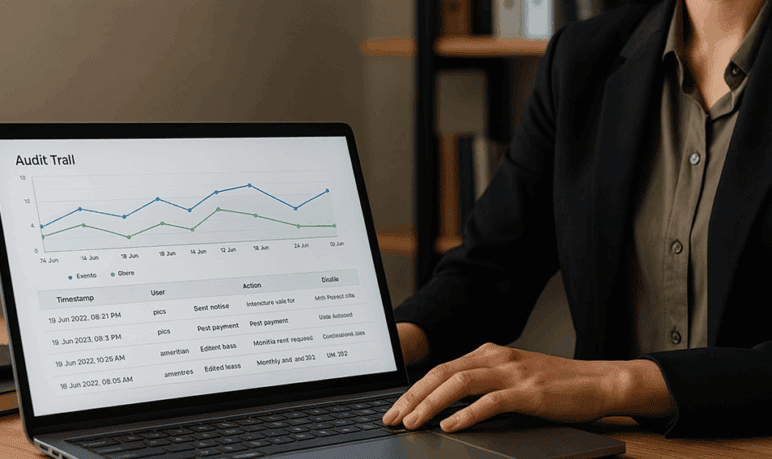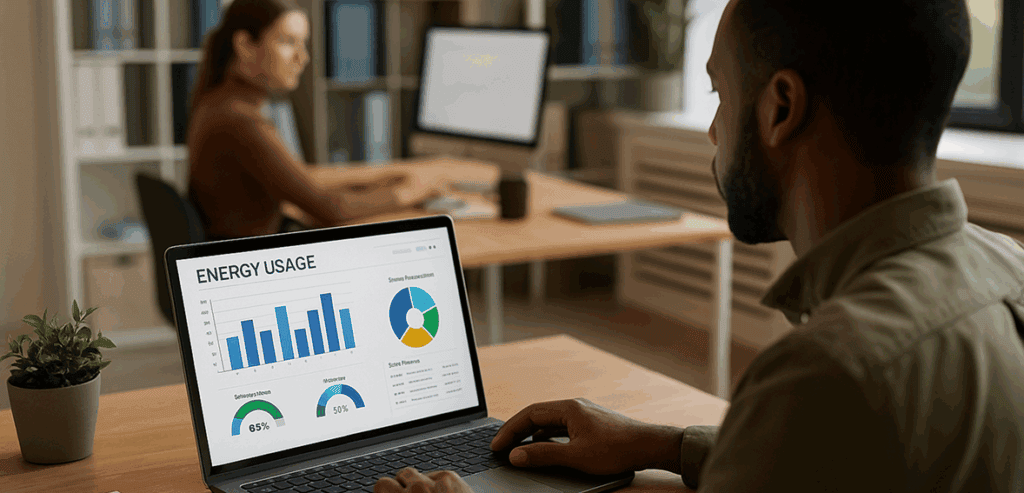
by Inez Kim August 7, 2025

The demand for sustainable practices is rising across every industry, and real estate is no exception. Today, property owners and managers are being asked to do more than just maintain buildings. They’re expected to reduce environmental impact, save energy, and support community well-being—all while improving operational efficiency. This is where sustainable property management plays a powerful role.
Modern software solutions are helping transform property management into a greener, more efficient discipline. From reducing paper waste and tracking energy usage to engaging tenants and staying compliant with environmental regulations, technology is unlocking new ways to manage properties with the planet in mind.
Energy Efficiency and Utility Tracking
Monitoring energy consumption is one of the cornerstones of sustainable property management. Traditionally, energy usage data was hard to collect and analyze. But with property management software and IoT integrations, that is rapidly changing. Managers can now track real-time energy performance across multiple buildings, set usage benchmarks, and receive alerts when consumption exceeds expected levels.
These systems offer features such as automated utility billing, detailed analytics dashboards, and anomaly detection. For example, if a property’s HVAC system begins consuming more power than usual, the software can alert the maintenance team to investigate. This reduces waste and helps avoid long-term damage.
According to the U.S. Department of Energy, sustainable buildings can reduce energy use by up to 50%. This is not only good for the planet but also for the bottom line. Utility expenses are a major operating cost, and reducing them adds immediate value to any real estate portfolio.
With energy efficient property software, retrofitting decisions can be data-driven. Managers can identify which units are ripe for insulation improvements, lighting upgrades, or smart thermostat installations. Software tools can track the return on investment (ROI) from each retrofit, helping justify further green investments.

Paperless Office and Digital Lease Management
Another quick win for both sustainability and operational efficiency is going paperless. Traditionally, property management has involved huge amounts of paperwork—from lease agreements and maintenance records to tenant communication and compliance documentation.
Modern eco-friendly rental management systems eliminate this clutter by digitizing it. Cloud-based platforms now support e-signatures, secure document storage, and online tenant portals. This shift not only saves thousands of sheets of paper each year but also drastically improves workflow efficiency.
Going paperless with software is a smart and simple step toward green property management practices. It makes it easier to access records, reduces physical storage needs, and minimizes printing and mailing costs. Digital lease management allows tenants to sign documents remotely, access files at any time, and submit forms without stepping into an office.
This is particularly useful for larger portfolios with multiple properties. With centralized systems, managers can access and organize documents from any location, speeding up lease renewals, rent processing, and reporting.
Beyond saving trees, these paperless solutions represent a shift toward modern, responsive management that today’s tenants expect.
Waste Reduction and Recycling Through Software
Waste management is often overlooked in discussions about property operations, but it plays a key role in reducing environmental impact. Software tools are now making it easier to schedule, track, and optimize waste collection, recycling, and composting across residential and commercial buildings.
Some platforms are designed specifically to support sustainable waste services. They allow managers to coordinate pickups, monitor recycling rates, and flag buildings where waste reduction targets are not being met. Others integrate with city services or third-party vendors to streamline pickup scheduling and reporting.
Resident engagement is another important piece. Property management apps can include recycling guides, reminders, or even gamified features that encourage tenants to participate in eco-friendly programs. Points systems, badges, or community leader boards can turn recycling into a friendly competition and increase participation rates.
The use of software in this area is especially valuable for multi-family properties, where tenant behavior directly influences sustainability outcomes. Encouraging residents to separate compost from garbage or break down packaging before disposal becomes easier when information is accessible and interactive.
By leveraging these tools, property managers can align waste strategies with broader sustainability in real estate operations, improving their eco-credentials while reducing service costs.
Green Maintenance Scheduling
Efficient building systems are essential for minimizing energy use and extending equipment life. This is where preventive maintenance takes center stage—and where software can be a valuable partner.
Maintenance software enables teams to create and manage schedules for inspections, servicing, and repairs. Regularly changing HVAC filters, servicing boilers, or cleaning ductwork can drastically improve system efficiency. Instead of relying on memory or spreadsheets, automated reminders help keep everything on track.
When equipment runs optimally, it consumes less energy, needs fewer emergency repairs, and lasts longer. This ties directly into energy efficient property software, which tracks both performance and maintenance outcomes over time.
Another area where technology helps is planning and coordinating green upgrades. If a property is switching to LED lighting or installing solar panels, software can help manage vendor timelines, project budgets, and ROI tracking. The ability to monitor savings and efficiency gains makes it easier to justify and replicate these initiatives across other properties.
Using data-driven maintenance not only supports sustainable property management but also boosts tenant satisfaction. When systems run smoothly, there are fewer disruptions and complaints. This improves retention, reduces churn, and contributes to long-term cost savings.
Tenant Engagement in Sustainability
Sustainability works best when everyone is on board—including the people living or working in the building. Many modern property management platforms come with resident portals and communication tools that can support eco-conscious living.
These tools allow property managers to share water-saving tips, energy conservation reminders, or updates on building-wide green initiatives. Tenants can also track their own energy usage if smart meters are integrated, giving them visibility into their consumption and the ability to make informed choices.
A well-designed tenant engagement strategy reinforces the brand’s environmental values. It also builds community. For example, a portal might include a digital bulletin board where tenants can share second-hand goods, rideshare opportunities, or local green events.
More importantly, this kind of communication adds marketing value. A recent survey showed that 73% of millennials are willing to pay more for eco-friendly homes. Highlighting green features through tenant communication platforms can increase property desirability and support pricing strategies.
By involving tenants directly, property managers create shared responsibility for sustainability. This is one of the most effective ways to turn green property management practices into a long-term competitive advantage.
Compliance and Green Certifications
Environmental regulations are tightening around the world. In cities like New York, Local Law 97 requires buildings over a certain size to reduce greenhouse gas emissions, with stiff penalties for noncompliance. Meeting these standards requires precise data and documentation—something software is well-suited to handle.
Property management platforms can track energy consumption, carbon output, and historical usage trends to ensure compliance. Dashboards offer insights at both the building and portfolio level, making it easier to identify problem areas and plan corrective action.
Beyond compliance, software helps properties qualify for green building certifications like LEED, ENERGY STAR, or BREEAM. These certifications require detailed data on energy usage, materials, water consumption, and more. Centralized software systems can collect, format, and submit this data efficiently, removing manual errors and speeding up approval.
Being certified as a green building is more than just a label. It can improve property value, lower insurance premiums, and attract better tenants. For property owners, it is an investment that pays off both financially and reputationally.
Using software to manage this process aligns perfectly with sustainable property management, where the goal is not just to comply with minimum standards but to exceed them with smart, efficient practices.
Software as a Driver of Innovation in Real Estate Sustainability
The shift toward sustainability in real estate operations is not just about being eco-friendly. It’s about becoming smarter, more adaptive, and future-ready. Software is the tool that enables this transformation.
What makes property management software so powerful is its scalability. A single dashboard can give managers insight into hundreds of properties, with the ability to set goals, run comparisons, and make data-backed decisions in real time.
These platforms also support long-term planning. Whether you are managing a single building or a nationwide portfolio, software helps forecast utility costs, measure tenant satisfaction, and test different sustainability strategies.
Integration with other systems is also improving. Smart thermostats, energy meters, solar inverters, and EV charging stations can all feed data into centralized platforms. This creates a full view of property performance and helps managers identify which technologies are most effective in practice.
The more data that is available, the more accurate and customized the solutions become. From retrofits and maintenance to leasing and compliance, software ensures every sustainability decision is informed, trackable, and aligned with broader business goals.
Financial Benefits of Going Green with Software
Cost savings are a major driver of the move toward eco-friendly rental management. By using software to optimize utility usage, digitize records, and reduce maintenance issues, properties can become far more efficient and profitable.
Let’s consider the potential numbers. Reducing energy use by 20% in a commercial building could save tens of thousands of dollars per year. Avoiding one major system failure thanks to preventive maintenance could save even more. Eliminating paper leases and postage might cut administrative costs by 30% or more.
Green certifications, too, often result in rental premiums. Many renters, especially younger demographics, actively seek out sustainable living spaces. Buildings that demonstrate their environmental efforts through resident portals and visible upgrades stand out in competitive markets.
Software also helps reduce staffing costs by automating routine tasks and streamlining communication. Instead of chasing down late rent, printing notices, or juggling spreadsheets, property teams can focus on strategy and service.
All of this translates into better financial performance. Sustainable property management is not just about doing the right thing. It is about building a stronger, leaner business.
Overcoming Adoption Barriers
Despite the clear advantages, some property owners and managers hesitate to adopt new software. Concerns about cost, training time, or integration with existing systems often hold teams back. But these barriers are becoming easier to overcome.
Many cloud-based platforms now offer modular pricing, allowing users to pay only for the features they need. Setup is becoming faster, with pre-built templates and user-friendly dashboards. Training resources are usually included, and dedicated support teams help guide users through the transition.
In fact, the transition to sustainable property management software can be surprisingly smooth. Many vendors offer data migration, API integrations, and step-by-step implementation plans. What once took months now takes weeks or even days.
The key is to focus on long-term value rather than short-term disruption. With the right planning and support, software adoption becomes a catalyst for cultural change, positioning the business for growth in a green economy.
Building a Culture of Sustainability
Technology can only go so far without a cultural shift. To truly benefit from green property management practices, the entire organization—from the C-suite to the maintenance crew—needs to align around sustainability goals.
Software helps reinforce this culture. By making energy usage visible, automating green tasks, and showcasing progress, digital tools turn sustainability from an abstract idea into daily action. Team members are more likely to support initiatives when they see results in real time.
Leadership can also use software reports to celebrate successes and track team performance. Recognition programs, tenant feedback, and public commitments to sustainability build momentum and accountability.
This cultural buy-in is what separates trend-followers from true innovators in sustainability in real estate operations. It ensures that the green transformation is not just technical but also deeply human.
Final Thoughts: Where Green Meets Smart
Sustainability is no longer optional in property management. It is a defining factor in tenant attraction, regulatory compliance, and long-term financial health. And the best way to make sustainability real, measurable, and scalable is through software.
From tracking energy use to encouraging recycling, from going paperless to earning green certifications, sustainable property management tools provide the foundation for lasting environmental impact and operational excellence.
As the real estate industry continues to evolve, those who embrace eco-friendly rental management and leverage energy efficient property software will be better equipped to meet the demands of modern tenants and environmental standards.
FAQs
How can property management software improve energy efficiency?
Property management software can monitor and analyze energy usage across properties using IoT integrations and real-time data tracking. It helps detect abnormal consumption, automate utility billing, and identify inefficient systems. With access to usage trends, managers can plan retrofits, like installing smart thermostats or LED lighting. According to the U.S. Department of Energy, energy-efficient buildings can reduce utility bills by 30–50%, making software tools critical for achieving those savings.
What are the benefits of green property management?
Green property management improves operational efficiency, attracts eco-conscious tenants, and ensures compliance with local environmental laws. It also helps reduce waste, lower utility costs, and extend the lifespan of building systems. Data shows that 73% of millennials are willing to pay more for sustainable housing, making eco-friendly practices not just good for the planet but a smart business move too.
What features should I look for in sustainable property management software?
Look for platforms with energy tracking dashboards, digital lease and document management, preventive maintenance scheduling, and resident communication tools. Integration with smart meters, recycling services, and compliance reporting systems can further support sustainable property management goals. Cloud-based access and mobile support also enhance adoption and ease of use.
Can going paperless really make a difference in sustainability?
Yes. Moving to digital leases, e-signatures, and cloud-based records significantly reduces paper waste and storage needs. It streamlines communication and reduces mailing costs, while also shrinking a property’s carbon footprint. Going paperless is often one of the quickest wins in green property management, with both environmental and operational benefits.
How does software support compliance with energy and emissions laws?
Modern property management systems help track emissions, monitor energy usage, and generate reports required for local compliance (e.g., NYC’s Local Law 97). These systems can also assist in meeting green building certifications like LEED or ENERGY STAR by collecting and organizing the necessary sustainability data.